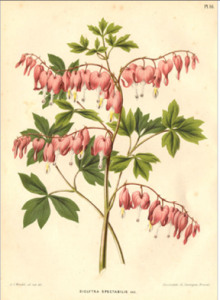Fortune’s Blooms

Dicentra Spectabilis, or Bleeding Heart, introduced to the West by Robert Fortune.
I‘m planning out a garden and thinking about blooms—and botanical hunters—today. It used to be in centuries past that sailing captains, missionaries and professional botanists made it their business to hunt all over China for new flower to export to Europe , facing serious danger in the form of strange diseases and hostile locals all along the way.
One of the first of such daredevils was botanist Robert Fortune, hired by England’s Royal Horticultural Society to travel to China in the early 1840s. Fortune packed three pistols in his luggage (and used them against pirates). He survived fierce fevers and two typhoons, all described in his book, Three Years Wanderings in the Northern Provinces of China (1847). The Chinese government limited Fortune’s travel to the Guangzhou district, but he shaved his head, grew a pigtail and wore the local costume in order to venture beyond in search of exotic varietals to satisfy the serious Western craving for new plants.
Fortune’s haul included over 200 species, including the cloud brocade rhododendron, Rhododendron fortunei, found in Zhejiang province south of Shanghai, as well as winter jasmine, Japanese anemone, pompon chrysanthemum, and bleeding heart (which my grandfather used to call ‘lady-in-a-bathtub’ instead). He visited China’s famous Fa-Tee nursery, learned cultivation of the chrysanthemum and ancient bonsai techniques.
His Fortune’s Double Yellow rose was met with much excitement in 1846. But in England it was a “straggling plant.” As one critic put it, “In its present state, this plant has little claim to English notice.” (It fares better in the warmer parts of the US.)
Fortune was more successful in his next risky undertaking. He illegally transported and transplanted Chinese tea plants in India in 1848, while working for the British East India Company, establishing the foundations of the massive Indian tea trade.

Comments